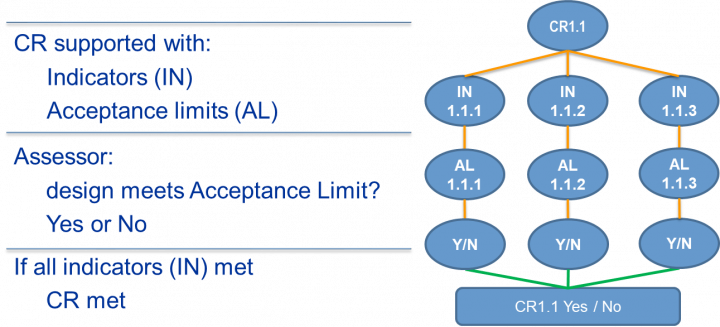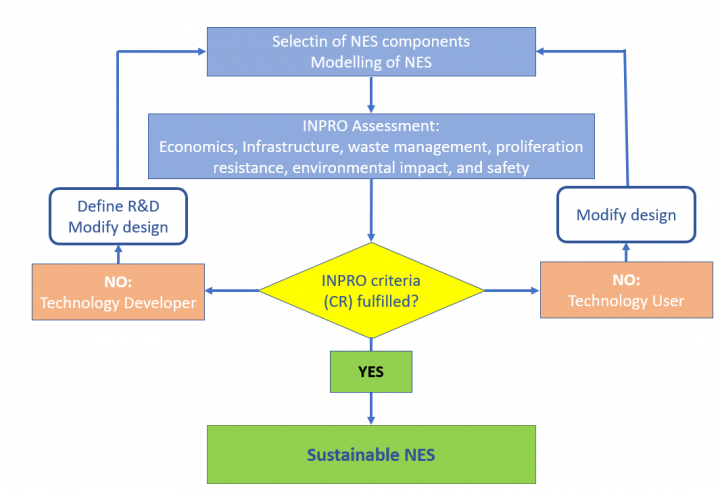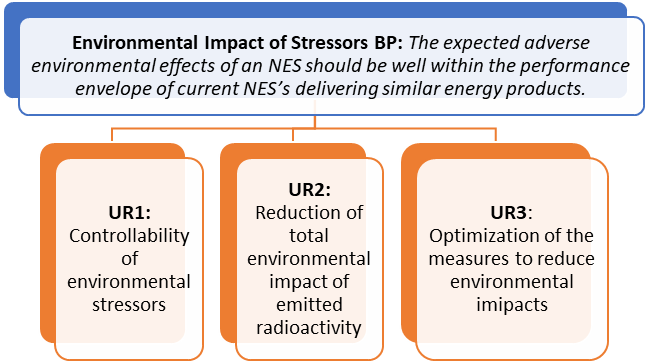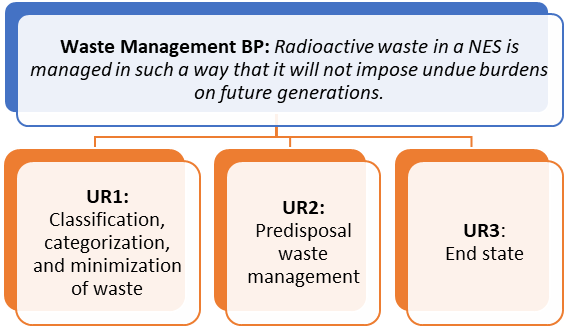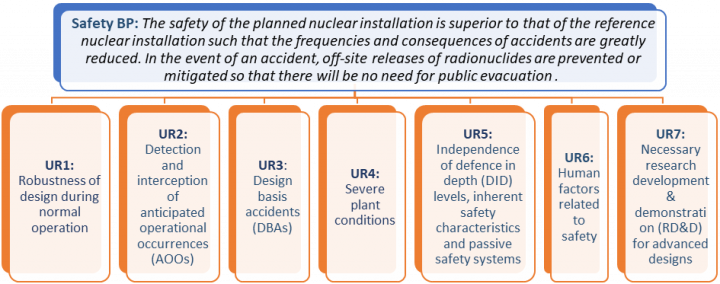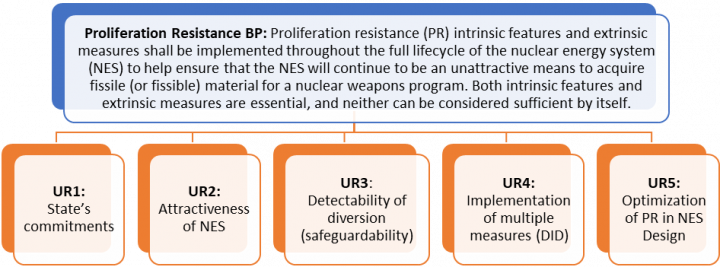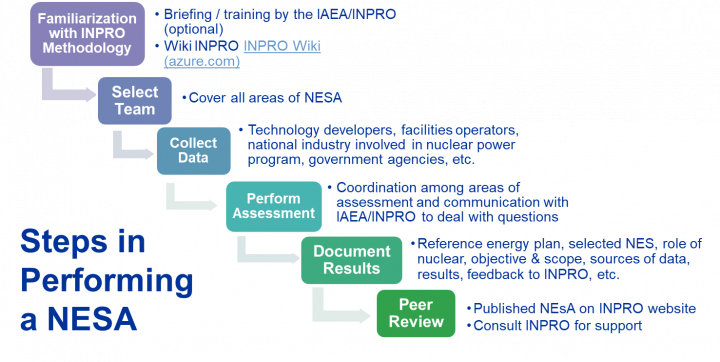INPRO methodology
INPRO developed a methodology for performing a sustainability assessment of nuclear energy systems. An INPRO sustainability assessment of nuclear energy addresses the four UN areas with six key assessment areas: economics, safety, environmental impact, waste management, proliferation resistance and infrastructure.
The development of the INPRO methodology was through consultancy and technical meetings with INPRO member states, international experts, and evaluation over time. In 2008 the IAEA published “Guidance for the Application of an Assessment Methodology for Innovative Nuclear Energy Systems, INPRO Manual-Overview of the Methodology”, INPRO also published the lessons learned document after applying the methodology in 2009. Since then, INPRO has been updating the INPRO manuals in six areas with 9 INPRO manuals, as shown in Figure 3. These manuals support the INPRO Methodology for Sustainability Assessment of Nuclear Energy Systems.
Contents
Framework of INPRO methodology
INPRO used the goals to develop a fundamental basic principle (BP) for each assessment area. Each assessment area has one fundamental BP, which defines the goal or target that the NES needs to achieve to be sustainable.
In the INPRO methodology each BP has user requirement (UR) and criteria (CR) which enables an assessment of the NES for sustainability. A UR defines what should be done to meet the target/goal of the INPRO methodology basic principle (BP). The UR is for specific institutions (users) involved in nuclear energy development, deployment and operation, i.e., the developers/designers, government agencies, facility operators, and support industries. A CR enables the INPRO assessor to determine whether or how well a UR is being met by a given NES. A logical CR is associated with some important feature of (or measure for) an NES and is usually presented in the form of a question that has to be answered positively. Figure 4 shows the framework of INPRO methodology. Each assessment area/manual has a BP; with 2-7 UR per BP; and 1-6 CR per UR.
Nuclear energy system assessment (NESA) process
In summary an assessment using the INPRO methodology is a process of making a judgement about the long-term sustainability of an evolutionary or innovative NES. The fulfilment of URs is checked by an assessor via CR.
A criterion consists of an indicator (IN) and an acceptance limit (AL).
An indicator (IN) is part of the criterion. The INPRO methodology uses two types of indicators: numerical and logical. A numerical indicator may be based on a measured or calculated value that reflects a property of a nuclear energy system (NES), such as the probability of severe core damage after an accident. A logical indicator is usually associated with some necessary feature of an NES and usually is presented in the form of a question, with either a positive (yes) or negative (no) assessment.
An acceptance limit of an INPRO criterion (CR) is a target, either qualitative or quantitative, against which the value of an indicator (IN) can be compared by the INPRO accessor leading to a judgement of acceptability (pass/fail, good/bad, better/poorer). In correspondence to the two types of indicators there are also two types of acceptance limits, numerical (for quantitative targets) and logical (for qualitative targets). Typically, a logical AL is a positive (yes) or negative (no) answer to a question raised by the indicator.
The sustainability assessment in the CR-level appears in Figure 5. When the CR are met the NES is considered sustainable. When the CR are not met it identifies gaps and thus gives the developer, designer, or State a chance to change the design of or options in an NES, to lead to a sustainable NES. Sustainability covers an NES for its entire lifecycle, from design through construction, operation, and decommissioning.
Figure 6 shows the process of assessing the sustainability of a nuclear energy system. The steps are as follows:
- Select the NES and the associated components.
- Collect design information including the functioning of the NES or a component, and any additional information needed for the assessment.
- Decide on the INPRO areas for the assessment. A full INPRO assessment covers all six area, or a limited scope assessment just covers one or more areas.
- Criteria fulfilled for all the UR?
- Yes, NES sustainable;
- No, modification to the NES. Technology User can Modify NES; Technology Developer can modify / Define R&D needs to close gaps.
- Reassess to confirm sustainability
The ultimate goal of INPRO methodology assessment is to check whether the NES fulfils all the CR and hence UR, and BP, therefore represents a long-term sustainable system for a MS or MS-Group. The NESA can help designers, technology holders, and States by identifying gaps and weaknesses in the NES. These assessments then give States and designers the opportunity to make changes in the design or planning stages of an NES when it is much more cost effective. This process supports the development of more sustainable options. Furthermore, the NESA is helpful for a State when comparing two options for an NES, or looking at synergies in options, to aid in identifying the option(s) that is the most sustainable for their needs.
The areas and basic principles in NESA
Therefore, there are a total of 8 INPRO manuals for the assessment of a nuclear energy system. Each area has one BP, and from 2-7 CR. This section gives a more in depth look into each assessment area.
Economics
For an NES to meet long-term sustainability, the nuclear energy must be available and affordable. Nuclear energy must be competitive with other energy sources, not necessarily the cheapest option. Figure 7 contains the INPRO BP for economics along with user requirements.
Environment
There are two aspects regarding the environment. One aspect concerns the environmental impact from depletion of resources, and the other discusses the environmental impact of stressors.
Environment Impact from Stressors
Fig. 8 shows the BP and UR for an INPRO sustainability assessment in environment impact from stressors.
Environment Impact from Depletion of Resources
Fig. 9 shows the BP and UR for an INPRO sustainability assessment in Environment impact from depletion of resources.
Waste Management
Fig. 10 shows the BP and UR for an INPRO sustainability assessment in waste management.
Safety
The safety principles and requirements developed within INPRO are based on extrapolation of current trends and seek to encompass the potential interests of developing countries and countries in transition. For nuclear reactors, the fundamental safety functions are to control reactivity, remove heat from the core, and confine radioactive materials and shield radiation. For fuel cycle installations, they are to control sub-criticality and chemistry, remove decay heat from radionuclides, and confine radioactivity and shield radiation.
Safety of Nuclear Reactors
Fig. 11 shows the BP and UR for an INPRO sustainability assessment in Safety of nuclear reactors.
Safety of Nuclear Fuel Cycle Faculties
Proliferation Resistance
Fig. 12 shows the BP and UR for an INPRO sustainability assessment in proliferation resistance.
Infrastructure
Fig. 13 shows the BP and UR for an INPRO sustainability assessment in infrastructure.
Performing a NESA
Fig. 14 shows the steps in performing a NESA.
Case study
INPRO methodology has been applied several times to the nuclear energy systems based on evolutionary water cooled reactors, as well as sodium cooled fast reactors. The NESA of Belarus can be seen in INPRO Assessment of the Planned Nuclear Energy System of Belarus, and the NESA of BN-1200 can be seen in Limited Scope Sustainability Assessment of Planned Nuclear Energy Systems Based on BN-1200 Fast Reactors.



